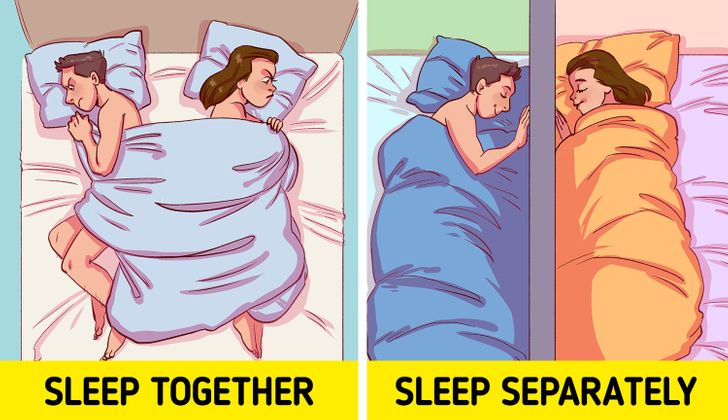According to a survey, only 14% of couples sleep in separate beds every night. And while many of us might believe in the saying “couples who sleep apart grow apart” there are studies that show the opposite is actually true.
We at Bright Side believe that there are no wrong or right sleep arrangements, because to some, sleeping in different beds can be as pleasing as for others sharing a bed with their partner.
A poor night’s sleep can turn lovers into fighters.

According to research, sharing a bed with a partner that has restless sleep behavior can deprive you of 49 minutes of sleep each night. And, when one partner doesn’t get a proper night’s sleep because of the other, it will most likely result in a conflict between them the next day.
Actually, the study even confirmed that couples who tend to have a poor night’s sleep have more severe and more frequent fights than those who wake up well-rested. People who get a good night’s sleep, on the other hand, are more likely to be in a good mood, have lower stress levels, and be more patient.
Resenting your partner because you can’t get a good night’s sleep can be destructive to the relationship.

Snoring, fidgeting, and bed or blanket hogging are just a few of many reasons why some couples choose to sleep in different beds or even in different bedrooms. Lying awake listening to your partner snoring while you beat yourself up to fall asleep can lead to a build-up of anger, tension, and resentment toward your partner.
According to Jennifer Adams, author of Sleeping Apart Not Falling Apart, sleeping in a separate bedroom can even help a relationship thrive because both partners are not sleep deprived.
Each partner can tailor their sleeping conditions to their heart’s content.

Tina Cooper, a licensed social worker, sleeps in different bedrooms with her partner because of their opposite sleeping habits. “I’m a night owl, he’s an early bird. I need soothing sounds to fall asleep, and he likes silence. He likes a hard mattress, and I like soft and full of pillows. And because I don’t like the early day’s sunlight, my boyfriend gave me the master bedroom which gets less light and he has the second largest room that gets the sunrise he loves.”

How you spend the nighttime in your shared bedroom with your partner can also influence your daytime functioning, marital satisfaction, and psychological and physical health. And when 2 people with different bedtime preferences and nighttime schedules end up together, changing themselves just to please their partner’s needs might harm their relationship in the long run.
Sleeping in different bedrooms with your partner means that the 2 of you will have a place just for yourselves where you can relax after an exhausting day. This way, both of you can satisfy your needs without tiptoeing around and worrying about whether your partner might wake up because you want to watch the latest episode of your show before bed.
Even if you don’t remember waking up, disturbed sleep can have a negative impact on your overall health.

During the night, our brain cycles through the stages of sleep several times: light sleep, deep sleep, and REM (Rapid eye movement sleep). But when you interrupt the cycle by waking up during the night, it means that your brain spends more time in the light sleep stage and misses out on REM. And without sufficient REM your emotional well-being and cognitive performance suffer.
Interrupted sleep can also have short and long-term health consequences, like hypertension, weight-related issues, mental health problems, reduced quality of life, and other health-related issues.
People on Reddit share why they decided to sleep separately with their partner.

- “Because a good night’s sleep is more romantic than sharing a bed. I snore and toss and turn. He gives off literal village levels of heat in his sleep and I can’t stand the heat. I read, he can’t stand light. We keep different hours to an extent. A million reasons. We get along so much better this way.” — crankyweasels
- “My partner and I have completely separate bedrooms. We ’sleepover’ occasionally in each other’s rooms. However, we both sleep exponentially better apart. He’s a night owl and I’m an early bird. He wants only one sheet on him, I want 10 lbs of blankets. In addition, having a separate room allows me to decorate it however I want, have my own personal space, and keep it to the level of cleanliness I prefer. People look at us sideways when I mention the separate rooms thing, but it’s been a game-changer.” — eriasana
- “Different sleep cycles due to different work schedules. We are still madly in love and we both agreed to this because it’s the best for both of us.” — AFishInATank
- “Early in our relationship, 90% of our fights occurred in the bedroom. I like to sleep in a cold room with the fan on and white noise like a box fan. I also like to go to sleep with the TV on. She likes to sleep in a warm, still, cave in complete silence and darkness. We started sleeping in separate rooms and all of a sudden 90% of our fights stopped. Also, because we were getting real sleep, other fights turned more into heated discussions.” — ttc8420
What are your sleeping arrangements with your partner? Do you believe sleeping in different beds can help a relationship thrive?
Bridget Moynahan: Finding Love and Happiness after Heartbreak

Bridget Moynahan, who suffered a heartbreaking breakup with professional player Tom Brady, has at last found happiness. Everyone recalls Moynahan and Brady’s breakup after two years of dating. When Moynahan disclosed that she was three months pregnant with their child, it was a difficult moment. Moynahan’s journey as a single mother was prompted by an unexpected turn of circumstances, but she has since found love and happiness once more. Let’s explore her motivational tale!

Accepting Being a Single Mother
In a candid 2008 interview, Moynahan talked about her unanticipated experience as a single mother to Harper’s Bazaar. She yearned for a caring companion in her life, but she had never envisioned raising a child by herself. Moynahan’s pregnancy announcement was difficult to accept because of her traditional views, which include getting married before having children. “It took me a minute to realize that this was the way I was going to raise a family,” the woman remarked.
An Intricate Bond with Tom Brady
When they parted ways amicably in 2006, Moynahan’s relationship with Tom Brady took an unexpected turn. Moynahan found out she was three months pregnant shortly after the separation, but Brady had already moved on with supermodel Gisele Bündchen. Moynahan had to deal with the challenges of becoming pregnant and parenting in the spotlight. She acknowledged that this was not the life she had imagined, saying, “I don’t think anyone grows up thinking they want to be a single mom.”

Brady and Bündchen went on to have their own family, while Moynahan concentrated on raising their son Jack. More than she could have ever imagined from her modeling and acting professions, Moynahan found comfort in her job as a mother.
The Joy of Parenting
Moynahan’s 2019 book, Our Shoes, Our Selves, goes into detail about her hardships during that time. She was open about how uncomfortable she felt being in the spotlight while she was pregnant, but she accepted motherhood in spite of the difficulties. In a statement about her love of motherhood, Moynahan said, “You think he’s a genius every time he does something.” He is exceptionally intelligent. Moynahan’s life has changed since becoming a mother, and she treasures every second she spends with her kid.

A Fresh Start
When Moynahan connected with Andrew Frankel through mutual friends, her personal life began to turn around. After being engaged in 2015, they married in secret at a New York vineyard later that year. When Moynahan eventually achieved her happily ever after, a private celebration was held to honor their union. Supporters applauded Moynahan, recognizing that following her path from a public split to single parenting, she earned this pleasure.

Together with Frankel’s three sons from a previous relationship, Moynahan and Frankel have formed a blended family. Love is all around Jack, and Moynahan is thankful for the extended family he has in his life.
An Account of Fortitude
The narrative of Bridget Moynahan is one of tenacity and accepting life’s uncertainty. As a mother, she has demonstrated strength, resolute in her desire to provide her child love and support. Despite the challenges we encounter, Moynahan’s path serves as a reminder that it’s never too late to discover happiness and love.
Comment below with your thoughts on Bridget Moynahan’s amazing experience!



Leave a Reply